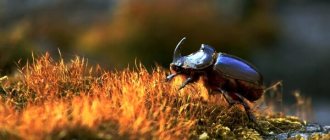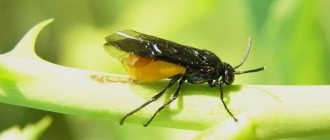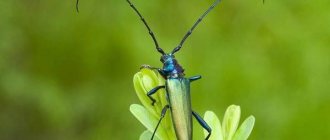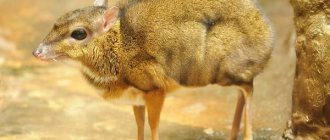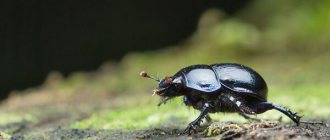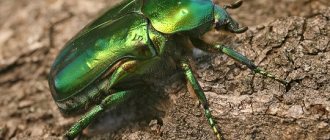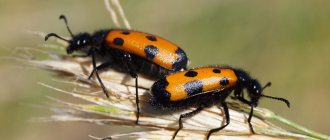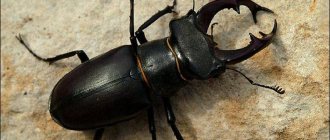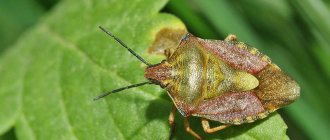The stag beetle (Lucanus cervus) is a large insect with striking external features. This species is becoming increasingly popular among lovers of exotic pets. It belongs to the genus of stag beetles of the same name (Lucanus), which includes about 50 species. The stag beetle got its name in honor of Lucania (a region of Italy), where it was used as an amulet.
It should be noted that the population of this unusual beetle is steadily declining. For this reason, it is most often bred under artificial conditions in order to increase the population in a certain area, and not for further sale as a pet.
Stag beetle, appearance
Origin of the species and description
Photo: Stag Beetle
Stag beetles are called Lucanus, which means “living in Lucania.” In their homeland they are used as amulets. Over time, this name was assigned to the entire genus, which today numbers more than fifty species. Only at the end of the nineteenth century did a more familiar name appear - “stag deer”, dictated by the extraordinary appearance of the animal.
The insect with unusual horns is the largest representative of beetles in Europe. It belongs to the Rogachi family. The insect's horns are quite massive and immediately stand out against the background of the body. You can see small spikes on their surface. The spikes have pointed ends that point inward.
Video: Stag beetle
The length of the male usually reaches eight centimeters, the female is half as long - on average, four centimeters. However, a real record holder was found not long ago in Turkey. Its length was ten centimeters. What are commonly called beetle horns are not actually horns. These are modified upper jaws.
They serve as a means of protection against natural enemies, as assistants in obtaining food, and as a real decoration of the species. Such jaws have a slightly reddish tint. They can even exceed the size of the entire body of the insect and in flight often outweigh the chest and abdomen. For this reason, beetles are forced to fly in an upright position.
Appearance and features
Photo: Stag beetle Red Book
The stag deer is a fairly large insect. Its body consists of a belly, chest, and head. The belly is completely covered by elytra, and three pairs of legs are visible on the chest. The animal's eyes are located on the sides of its head. The body length can reach eighty-five millimeters including horns. It is the males that have these dimensions. Females are much smaller - their body length does not exceed fifty-seven millimeters.
Females are not only smaller, but they also look normal. They lack the main decoration - huge reddish horns. The legs, head, prodorsum, scutellum, and lower part of the entire body of the stag beetle are black. The combination of a black body with reddish horns makes the beetle unusually beautiful. It is difficult to confuse him with anyone else. Males use massive horns exclusively for fights with other representatives of insects, with other males.
Females lack such weapons, so they use their sharp jaws for defense. They are very powerful. The female can even bite through rough skin, for example, like on the fingers of an adult. Despite well-developed jaws, huge horns, and great physical strength, stag beetles do not eat food in a solid state. All these accessories are used only for defense in case of danger.
Variability
Variability of the stag beetle. From left to right -
Male f. media, male f. major, male f. minor
. There is a noticeable difference not only in the size of the male mandibles, but also in the size of the beetles themselves
Several forms of stag beetles have been identified, differing in the size of the mandibles in males and the shape and proportions of the pronotum[4]. The occurrence of polymorphism, as in other beetles, is associated with the conditions of larval development, the amount and availability of suitable and accessible food (trophic polymorphism), and environmental conditions. For example, with increased dryness of the climate, the conditions for the development of larvae worsen, and subsequently smaller individuals emerge from them[23].
The following forms of stag beetles are known:
- f. major - the large internal tooth of the mandibles is sharp and not shorter than the apical teeth [4].
- f. media—the large internal tooth of the mandibles at the apex is obliquely cut and shorter than the apical teeth[4].
- f. minor - all internal teeth of the mandibles are weakened, the projections of the head are smoothed [4].
| Male head f. major | Male head f. media | Male head f. minor |
Where does the stag beetle live?
Photo: Male stag beetle
The stag beetle is a common insect.
He lives in different parts of the world:
- in Europe - from Sweden to the Balkan Peninsula. But in some countries this animal species has become extinct. We are talking about Estonia, Denmark, Lithuania and most of the UK;
- in some hot countries - Asia, Turkey, North Africa, Iran;
- in Russia. This beetle is very widespread in the European part of the country. Local populations are observed in the Penza, Kursk, and Voronezh regions. In the north, beetles have been spotted in Samara, Pskov, Ryazan and many other regions;
- in Crimea. On the peninsula, stag beetles live in mountainous and forested areas;
- in Ukraine. Similar insects live almost throughout the entire territory of Ukraine. The largest population is observed in the Chernigov and Kharkov regions;
- In Kazakhstan, you can also often meet a handsome stag. Beetles live mainly in deciduous forests, forest-steppe and near the Ural River.
The geographic location of stag beetle populations is associated with its biotype. The insect belongs to the mesophilic species. Such animals prefer to settle in deciduous forests, mainly where oak trees grow. In this case, the type of site does not matter. Insects live in both lowland and mountainous areas. Only occasionally can the beetle be found in mixed forests and old parks.
In the Middle Ages, in some countries, particularly Great Britain, the discovery of a stag beetle was considered an omen. So, landowners believed that this insect foreshadowed the imminent death of the entire crop.
Habitats of staghorns
Representatives of the family Lucanidae are most numerous in forest areas of the tropics; they are also found in the subtropics and in temperate regions. Only two dozen species from the large family of stag beetles live in Russia.
For a colony of beetles to appear, there must be enough stumps and fallen trunks in the forest. This is explained by the fact that the larval stage of stag beetles occurs almost entirely in old trunks and stumps. It is not entirely known which specific tree species are preferred by stags. The larvae are often found near old stumps of oaks, cork oaks, as well as palms and other tropical trees. One of the factors that really matters is the age of the trunks or stumps. Horn beetles prefer wood at the stage of deep decomposition, although each species of beetles from the family Lucanidae has its own preferences. For example, the stag beetle (Lucanus cervus) develops primarily in trunks with a diameter of more than 20 cm or stumps of trees that died at least five years ago.
What does a stag beetle eat?
Photo: Stag Beetle
Powerful jaws, sharp horns, and physical strength allow the stag beetle to eat solid food. However, representatives of this species prefer to feed only on the sap of trees and other plants. However, to obtain such food you also need to try. Tree sap rarely flows out on its own. To get a portion of food, the stag beetle has to gnaw through the bark of trees with its powerful jaws. When the juice appears on the surface, the insect simply licks it off.
If there is not enough sap, the beetle moves to another tree or succulent plant. If there is enough food, the stag beetle begins to behave calmly. Its natural aggressiveness fades into the background and the insect grazes peacefully in the same area for some time. The stag deer is a real find for lovers of exotic things. Many people keep these insects at home. For feeding, use sugar syrup or an aqueous solution of honey.
Features of character and lifestyle
Photo: Stag beetle from the Red Book
You can spot an adult stag beetle as early as the end of May. Their population is especially large in places where oak trees grow. During the day, these animals are least active. They can sit peacefully on a tree all day, basking in the sun. Deer beetles come out in search of food at dusk.
Not all insects of this species adhere to a nocturnal lifestyle and feeding. Those who live in southern Europe prefer to be active during the day. At night they rest. During daylight hours, an insect can fly about three kilometers. Such distances are easily overcome by males. Females are less active and move little.
The flight of a stag beetle is hard to miss. They fly very hard and make a loud noise in the process. It is extremely rare for insects to take off from the ground or any other horizontal surface. For this reason, they have to fall from tree branches or bushes to take off. During the flight itself, males are forced to maintain an almost vertical position. This is due to the large size and impressive weight of the horns.
The character of the strong stag beetle is grumpy. However, aggressiveness is inherent only in males. Females do not show their aggression without reason. Males often organize competitions among themselves. The subject of the “dispute” can be food or a female. During the battle, rivals attack each other with powerful horns. With their help, they try to throw the enemy from the tree.
Despite the power of the beetles' horns, fights between males do not end fatally. The horns are not able to pierce the body of a stag beetle, they can only injure. The fight ends with one of the males being forced to give up food or a female to the other.
Interesting Facts
Hornbills are amazing creatures, so their life simply cannot help but contain a lot of interesting things. Many interesting facts have already been told earlier. But there is also something I would like to add about the wonderful horns of these creatures and some other things.
- As you know, stag beetles are capable of flight. But their huge branched horns greatly disturb them in the air. To maintain balance, they have to take an almost vertical position during flight;
- Young beetles have horns from the first moments of their existence. As already mentioned, they need these devices to fight other beetles. Only their warlike aggression does not make itself felt immediately, but under the influence of circumstances. Unless there are special reasons, beetles, although they do not show great friendliness towards their own kind, do not harbor hatred either;
- The mandibles of staghorns are clear proof of how intelligently evolution works. If the toothy jaws of beetles had been preserved in their original form, that is, with sharp ends existing for grinding food, like their very distant ancestors, the pugnacity of the males would have led to the death of many individuals, and therefore the entire species. But the strong giants are only capable of raising their horns and throwing back the enemy with minimal consequences for him;
- Hornbills can fight not only over food, but also for the right to own a female. Before the start of the battle, they try to immediately make the right impression on the enemy. During this, the beetles stand on their hind legs, rearing up and demonstrating their strength;
- The weapons of males are horns, that is, the upper jaws. But females bite with their lower jaws, and quite strongly;
- The stag beetle was made famous throughout the world by the cartoon, which was one of the first to be published back in 1910. Since then, such insects have really become popular, and their image has appeared on coins and postage stamps.
Human activities have a detrimental effect on the population of these unique creatures. It is rapidly declining, and the biological species itself is considered endangered, despite active conservation measures. To draw people's attention to this problem, the stag beetle has been repeatedly recognized as the insect of the year in many countries. In particular, this happened in 2012 in Germany.
Social structure and reproduction
Photo: Horned deer
In the social structure, the main leadership positions belong to males. Males can compete with each other in relation to the female or food.
The process of prolongation of the genus of stag beetles can be represented in stages:
- Attracting males. The female is puzzled by the continuation of the race. She looks for a suitable place on the tree, gnaws the bark to attract a male with sap. To emphasize her intentions, the female lays her feces right under the gnawed bark.
- The choice of the strongest. Females mate only with the strongest males. Many individuals flock to the sap of the tree. However, when they see feces, they forget about food and begin to compete with each other for the female. Some weak beetles are eliminated on their own. Only the bravest remain to fight.
- Pairing. The strongest is the one who can knock all competitors to the ground. After the victory, the male mates with the female, then flies off to do his own thing. Reproduction occurs sexually.
- Egg deposition. Soon after fertilization, the female lays eggs. To do this, she chooses dry stumps and trees. There the eggs develop over the course of a month.
- Larval stage. Stag beetle larvae can reach one centimeter in length. During their development, they feed on particles of dead wood.
- Transformation into a chrysalis. If the larva can come to the surface, then the pupa begins its development underground. The process usually begins in the fall and ends in the spring.
- Life of an adult beetle. In spring, the pupa turns into an adult, handsome stag. The lifespan of an adult usually does not exceed one month. But in nature there were also long-livers. Their active life span was two months.
Nutrition
The beetle larvae grow on wood, feeding on it. Moreover, they do not need high-quality wood, but dead wood, simply rot. They are also not interested in living but diseased plants. Again, their varieties are very important. The favorite delicacy of the larvae is pedunculate oak and some other forest trees, but very rarely fruit trees.
Such food is no longer suitable for adults. What does a stag beetle eat ? In addition to dew and nectar, it feeds on the juice of young shoots of plants. In the literal sense, giants can also be called mash lovers. The greatest joy for them is to find a suitable oak tree, whose trunk has cracked from severe frosts in winter.
And with the arrival of warm days, through the cracks that have formed and have not yet healed, juice is baked out, which is very tasty and sweet for the beetles. Seeping through fresh cracks, from the heat of the generous summer sun it ferments a little and begins to foam.
Such “wounds” of oak trees are a desirable source of strength for these insects. This is where the giants' favorite drink comes into being. Here beetles graze in groups, gathering on tree branches. If there is plenty of juice, the feasting community interacts peacefully. But when the source begins to slowly dry up, then the warlike nature of the stags manifests itself.
For the most part, males initiate fights. In the fight for the “magic” drink, they organize real fierce tournaments. This is where the devices bestowed by nature come in handy - huge horns. After all, the upper jaws of the stag beetle exist for fighting.
Such battles most often turn out to be a very exciting spectacle, and the giants compete not in jest, but seriously. The strength of these creatures is truly heroic. One has only to mention that the weight they lift exceeds their own by a hundred times. By placing the enemy on the horns, the winners throw the losers off the branch. And the strongest remain at the blessed source.
Natural enemies of the stag beetle
Photo: Stag Beetle (stag beetle)
Stag beetles most often fight among themselves. Males have a warlike character and constantly engage in fights for the best food and females. However, such battles do not pose a serious threat to the animal. They end peacefully or with the slightest damage. Stag beetles are at their most defenseless at the larval stage. They cannot offer even the slightest resistance. The most dangerous enemy for the beetle during this period is the Scolia wasp. The Scolia wasp can completely paralyze a huge staghorn larva with just one sting. Wasps use the larval body to lay their own eggs.
Adult horned beetles suffer mainly from birds. They are attacked by crows, eagle owls, and owls. Birds feast only on their bellies. The remaining parts of the insect remain intact. However, the most dangerous enemy for stag beetles is humans. In many countries, these insects are hunted by exotic lovers and collectors. Collecting beetles leads to a significant decrease in their numbers and even extinction.
Fight for the female
Most often, horn jaws are used by beetles for combat . There can be many reasons for disagreements between males, for example, the fight for a female during the mating period. Each of the horns has 12 scars , but the beetles cannot seriously injure each other, and the fight ends when one representative throws the other off the branch.
Population and species status
Photo: Stag beetle from the Red Book
The stag beetle is an endangered species. The number of such insects is decreasing at a rapid rate every year.
This is influenced by many factors, most notably:
- poor environmental conditions. This problem is relevant for any continent. Air, water, land are highly polluted;
- uncontrolled forestry activities. Deforestation deprives horned beetles of their natural habitat, home and food;
- the presence of pesticides and other harmful pesticides in the soil. This factor affects the numbers of almost all insects;
- sabotage by humans. When you see a beautiful stag beetle, it’s hard to hold back your exclamations of admiration. Some people don't stop there. They catch insects for fun or for their own collection. In some countries, amulets are still made from stags, which are sold for a lot of money.
These and many other negative factors are very quickly reducing the stag population throughout the planet. Today this animal is endangered and is listed in the Red Book. And in 1982, the stag deer was included in the Berne Convention. To support an endangered species in some countries, the stag beetle has been chosen as insect of the year more than once.
